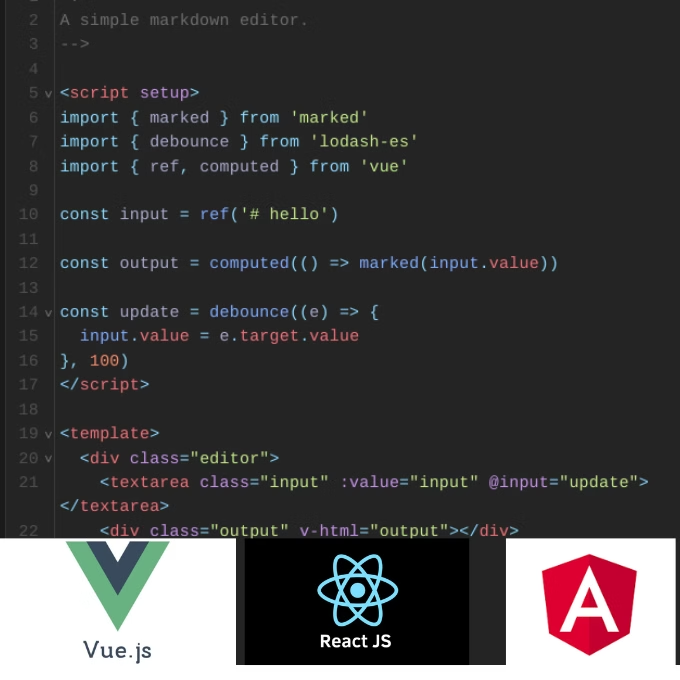Contents
The JavaScript ecosystem is constantly evolving, with it, the landscape of JavaScript frameworks. React, Vue, and Angular have emerged as the top three contenders, each with unique strengths and weaknesses.
What are the pros and cons of each framework;
How to create SEO strategies for single-page applications (SPAs), and
What about their performance;
Understanding the Big Three
React
React, designed by Facebook, is a library for building user interfaces based on components. Its prime focus rests on creating reusable UI components; therefore, it can be very flexible depending on the scope of the projects that calls for it.
React Pros:
- React is component-driven:
- It promotes modularity and reusability.
- Efficient Virtual DOM updates: It is faster in performance due to the efficient final DOM update.
- Large Community and Ecosystem: Plenty of support offered in terms of libraries and tools.
- Declarative Programming: This helps developers mainly focus on UIs by declaring the state that they want.
Disadvantages of React:
- Learning Curve: Somewhat requiring knowledge of JSX, state management principles.
- Too much boilerplate code: Usually very verbose in large applications.
Vue
Vue is a progressive set of libraries, so it can be used incrementally or as a full-fledged framework. It balances efficiency with the promise of being simple and elegant, making it widely embraced by developers.
Vue Pros:
- Gentle Learning Curve: It is really easy to pick up by newbies.
- Versatility: Useful for applications of small to very large scale.
- Fast: Smart mechanisms for rendering and updating.
- Documentation and Community: Grazes an excellent status with good documentation and community support.
And some negatives:
- Smaller Ecosystem: Vue has a somewhat smaller set of libraries and tools compared to React or Angular.
- Complexity Can Lead to Trouble: Managing states while the growth of an application can be stressful sometimes.
Angular
Angular is a web platform, and more recently a web framework, established by Google intended for the creation of highly complex web applications. It provides a whole array of tools and features extending from dependency injection, routing to form validation.
Advantages Angular Has to Offer::
- Complete Framework: The framework is thought of as a `full-fledged framework’ considering that it has all its necessary features to build, as well as maintain, large-scale applications.
- Strong Community and Support: Given that Google is behind Angular, huge communities also support it.
- TypeScript Integration: Improves code purity and maintainability.
- Performance Optimization: A multitude of methods allows optimization.
Disadvantages of Angular:
- Steep Learning Curve: Understanding Angular cannot be skin-deep, and alongside goes the learning of TypeScript.
- Opinionated Framework: This sometimes ends up becoming a barrier when working on the structure and approach for a given project.
SEO for SPAs
JavaScript-heavy entities such as SPAs could cause a lot of trouble in the crawling process. Now, some of the following methods might just get those SPAs search-engine friendly:
Server-Side Rendering (SSR):
- Render initial HTML on the server, making it easier for search engines to index content.
- Frameworks like Next.js (React) and Nuxt.js (Vue) provide built-in SSR support.
Dynamic Rendering:
- Rendering initial HTML at the server end for easy indexing by search engines
- Next.js (for React) and Nuxt.js (for Vue) have SSR capabilities bundled with them.
JavaScript SEO Best Practices:
- Meaningful HTML Structure: Employ semantic HTML elements with an absolute minimum of JavaScript rendering of content.
- Unique Titles and Meta Descriptions: Every page must have a descriptive and unique title and meta description.
- Internal Linking: Internal link structure to be properly followed by the engines to find the content.
- Mobile-Friendly: The SPA has to be optimized for a mobile use.
Performance and SEO Implications
JavaScript frameworks can really have slight changes in performance and SEO aspects of your site. Here is a list to check onto while optimizing your SPA:
- Code Splitting: Need to slice large JavaScript bundles and big ones for load-time improvements.
- Tree Shaking: Do away with codes that are not in use and thus bloat bundles.
- Minification and Compression: Take away unnecessary characters and compress for further reduction.
- Lazy Loading: This one loads JavaScript resources only if it is needed for the first-page rendering.
- Leverage Browser Caching: Setup proper cache headers for reducing pressure on servers.
- Optimize Images: Squeeze images by compressing and choosing the best formats.
- Minimize HTTP Requests: Combine and minify CSS and JavaScript files.
- Prioritize Critical Rendering Path: Make the most improvements on initial page-load time through the critical rendering path.
The choice of the JavaScript framework depends on your requirements, team skills, and long-term goals. Read reviews and understand the pros and cons of React, Vue, and Angular, so that you may make informed decisions while creating high-performance, scalable, and SEO-friendly web applications.

